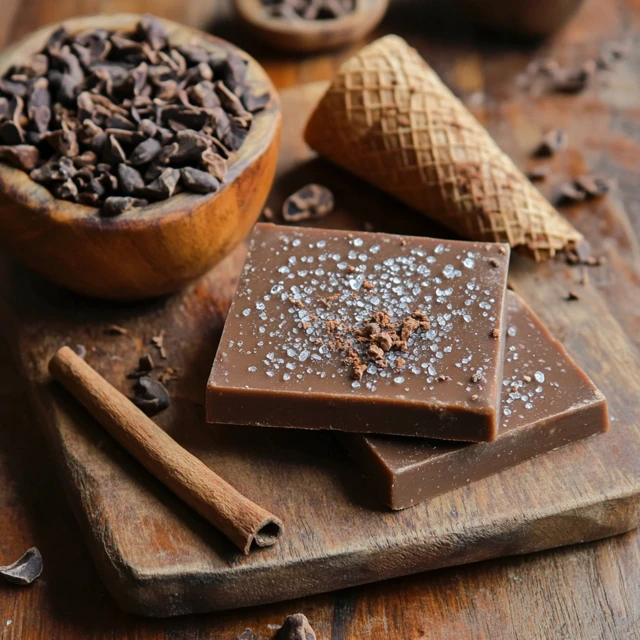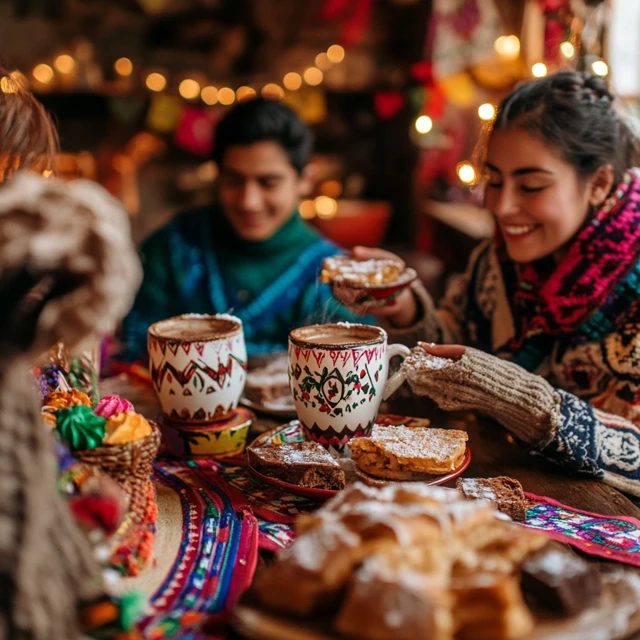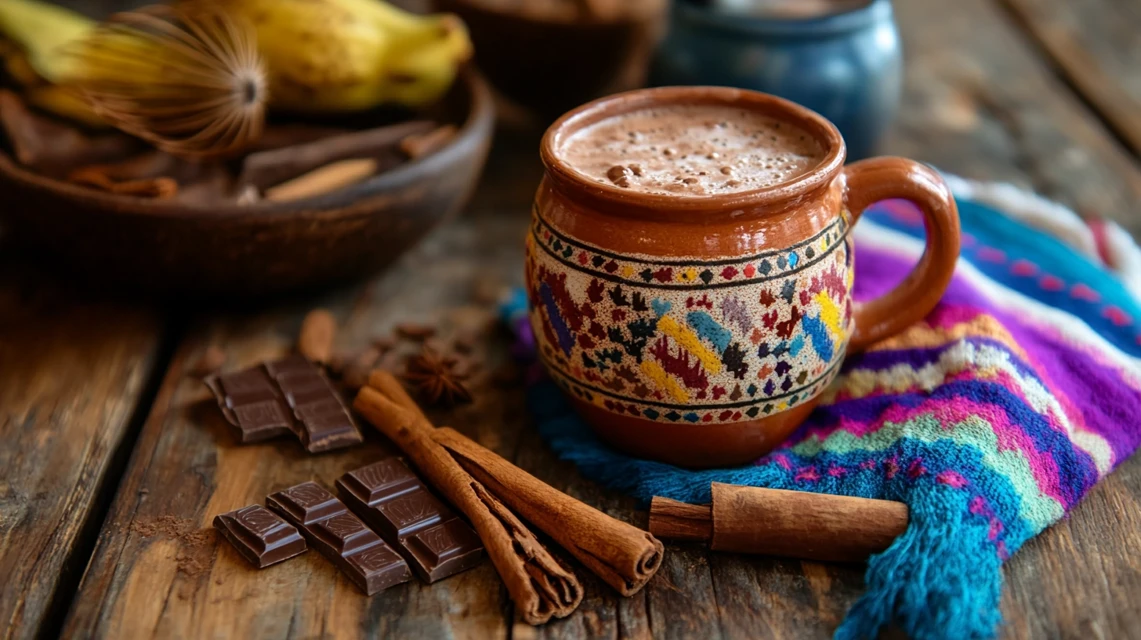What Is The Mexican Name For Hot Chocolate?
First of all, Mexican hot chocolate brings comfort and cultural richness to everyone who drinks it, and moreover, it comes from a deep history and tradition. In fact, people know it as chocolate caliente in Spanish, and furthermore, this beloved drink tells a story that goes back hundreds of years, bringing together old Mesoamerican ways with Spanish influences. As a result, both its special name and how people make it show off Mexico’s identity and heritage.
The Origins of Mexican Hot Chocolate

Mexican hot chocolate is much more than a simple drink; it represents the fusion of Mesoamerican and European cultures. Its origins date back to ancient civilizations, where cacao played a central role in rituals, cuisine, and daily life.
A Mesoamerican Heritage
The story of Mexican hot chocolate begins with the Aztecs and Mayans, who cultivated cacao and used it as a sacred gift from the gods. Known as xocoatl, their version of hot chocolate was far different from the sweetened beverage we enjoy today.
Key Features of Mesoamerican Hot Chocolate:
- Unsweetened: Xocoatl was typically bitter and often flavored with spices like chili and vanilla rather than sugar.
- Ceremonial Importance: Cacao was considered divine and was often consumed during rituals and offered to deities.
- Social Symbolism: It was a luxury item, consumed by royalty and warriors as a source of energy and status.
This early version of hot chocolate laid the foundation for what would become chocolate caliente.
How Spanish Influence Shaped the Name
When Spanish explorers arrived in Mesoamerica, they were introduced to cacao and its many uses. They brought cacao back to Europe, where sugar and milk were added, transforming the bitter drink into a sweeter, creamier version.
Impact of Spanish Influence:
- Introduction of Sugar: The Spanish added sugar, making hot chocolate more palatable to European tastes.
- Use of Milk: Milk replaced water in many recipes, creating the creamy texture we associate with modern hot chocolate.
- Linguistic Changes: The Spanish term chocolate caliente directly translates to “hot chocolate” and became the common name for the drink in Mexico.
This blending of Mesoamerican and Spanish traditions gave rise to the sweet and spiced version of hot chocolate enjoyed today.
Traditional Ingredients in Mexican Hot Chocolate
The unique flavor of Mexican hot chocolate comes from its carefully chosen ingredients, which reflect both ancient and colonial influences.
Key Ingredients:
- Mexican Chocolate Tablets: Made from ground cacao, sugar, and cinnamon, these tablets form the base of the drink.
- Milk or Water: Milk adds creaminess, while water creates a lighter, more traditional version.
- Cinnamon and Spices: Cinnamon is a staple, with optional additions like vanilla or chili powder for extra depth.
- Piloncillo: This unrefined cane sugar adds a rich, caramel-like sweetness.
These ingredients come together to create a drink that is flavorful, aromatic, and distinctly Mexican.
The Name and Its Meaning
The term chocolate caliente is simple yet deeply meaningful. It not only describes the beverage but also carries cultural significance tied to Mexico’s identity and traditions.
What Does Chocolate Caliente Mean?
The name chocolate caliente translates literally to “hot chocolate” in English. However, it signifies much more than just temperature or flavor.
Literal Meaning:
- Chocolate refers to the cacao-based element of the drink, rooted in the Nahuatl word xocolatl.
- Caliente indicates that the drink is served warm, a key aspect of its comforting nature.
The name captures the essence of a drink that provides both warmth and a connection to history.
Variations in Regional Terminology
While chocolate caliente is the most common name, regional variations in terminology and preparation exist throughout Mexico.
Examples of Regional Variations:
- Tabasco: Known for its artisanal cacao production, this region often uses locally crafted chocolate for their version of chocolate caliente.
- Oaxaca: In Oaxaca, chocolate de agua (water-based hot chocolate) is popular, highlighting a more traditional preparation method without milk.
- Yucatán: Here, hot chocolate may be flavored with unique spices like achiote, reflecting Mayan culinary practices.
These regional differences showcase the diversity of Mexican hot chocolate and its adaptability to local ingredients and traditions.
How the Name Reflects Cultural Identity
The name chocolate caliente embodies the blend of ancient and modern influences that define Mexican culture. It’s a symbol of how traditions evolve while maintaining their roots.
Cultural Reflections:
- Heritage: The use of cacao links the drink to its Mesoamerican origins, celebrating Mexico’s indigenous history.
- Community: Preparing and sharing chocolate caliente is a communal activity, often associated with family gatherings and celebrations.
- Adaptability: The incorporation of Spanish elements like sugar and milk shows how Mexican culture embraces and redefines external influences.
By simply saying chocolate caliente, one acknowledges the rich history and vibrant traditions behind this beloved drink.
How Mexican Hot Chocolate Is Made
Mexican hot chocolate stands out not only for its rich flavors but also for the traditional methods and ingredients used in its preparation. From the unique chocolate tablets to the aromatic spices, every step of making chocolate caliente reflects centuries of tradition and culture.
The Role of Mexican Chocolate Tablets
At the heart of Mexican hot chocolate are the distinctive chocolate tablets, which serve as the foundation of its flavor and texture. These tablets are unlike typical cocoa powders or chocolate bars, offering a rustic and authentic taste.
What Makes Mexican Chocolate Tablets Unique?
- Ingredients:
- First of all, makers grind cacao beans to create Mexican chocolate tablets, and furthermore, they add unrefined cane sugar (often piloncillo) and cinnamon to complete the mix.
- Some varieties include additional spices or nuts, such as almonds, for enhanced flavor.
- Coarse Texture:
- Unlike smooth, processed chocolates, Mexican chocolate tablets retain a grainy texture due to minimally processed ingredients.
- The sugar crystals and cocoa nibs remain intact, giving the drink its signature rustic feel.
- Popular Brands and Artisanal Options:
- Brands like Abuelita and Ibarra are widely available and beloved for their convenience and flavor.
- Many regions in Mexico also produce artisanal chocolate tablets, offering unique local variations.
These tablets are not just ingredients; they are a symbol of Mexico’s cacao heritage, connecting modern hot chocolate to its ancient roots.
Traditional Preparation Methods

First of all, Mexican hot chocolate carries deep traditions, and moreover, families have passed down their special ways of making it for generations.The process emphasizes the importance of blending ingredients and creating a frothy texture.
Step-by-Step Traditional Method:
- Heating the Liquid:
- Start by warming milk or water in a pot over medium heat. Water is often used for a lighter, more traditional version, while milk adds creaminess.
- Adding the Chocolate Tablets:
- Break the chocolate tablets into smaller pieces and add them to the hot liquid. Stir gently to help them dissolve.
- Using a Molinillo Whisk:
- The molinillo, a carved wooden whisk, is an essential tool in making Mexican hot chocolate. It’s rolled between the palms to mix the ingredients and create a frothy top layer.
- Blending the Ingredients:
- Keep whisking until first, the chocolate melts completely, and then as a result, you’ll see a thick layer of foam appear on top.
- Serving:
- Pour the hot chocolate into mugs and enjoy immediately. Many people pair it with pan dulce (sweet bread) or churros for a complete experience.
Modern Adaptations:
- While people traditionally use the molinillo, on the other hand, you can also create a similar frothy texture by using modern tools like handheld milk frothers or blenders.
- Microwaving the milk or water is a quick alternative for those short on time, though it lacks the authenticity of stovetop preparation.
This traditional process not only enhances the flavor but also preserves the cultural rituals associated with making chocolate caliente.
check out this https://eassyrecipes.com/category/breakfast/
Spices That Define the Flavor
First of all, what really makes Mexican hot chocolate special is that it uses a special mix of spices. Furthermore, these spices not only add richness and warmth but also, as a result, turn the simple act of drinking into something that delights all your senses.
Cinnamon: The Essential Spice
- Warmth and Sweetness: Cinnamon is a cornerstone of Mexican hot chocolate, complementing the rich cocoa with its sweet and aromatic notes.
- Traditional Use: First of all, many recipes tell you to simmer a cinnamon stick in the milk or water, and as a result, the cinnamon adds its rich flavor to the drink.
Chili Powder or Cayenne: A Subtle Kick
- Balance of Sweet and Spicy: A pinch of chili powder or cayenne pepper adds a gentle heat that contrasts beautifully with the sweetness of the chocolate.
- Mesoamerican Tradition: The inclusion of chili harkens back to the Aztec and Mayan use of spices in cacao-based drinks.
Vanilla: A Smooth Finish
- Aromatic Sweetness: Furthermore, people add vanilla which, as a result, brings out all the flavors and creates a smooth, rich taste.
- Common in Modern Recipes: While not always included in traditional recipes, vanilla has become a popular addition in modern versions of Mexican hot chocolate.
Optional Spices:
- Moreover, during festive occasions especially, people add nutmeg, star anise, and cloves to create an even richer flavor.
These spices not only define the flavor of Mexican hot chocolate but also connect it to its historical and cultural roots, making each sip a journey through time.
FAQs About Mexican Hot Chocolate
What Is The Mexican Name For Hot Chocolate?
First of all, Mexican hot chocolate brings together rich flavors, deep history, and long-standing traditions. As a result, people often ask about what makes it special and moreover, how it compares to other drinks. Therefore, to better understand why this drink matters so much and why people love it, here are answers to common questions.
check out this https://eassyrecipes.com/category/breakfast/
What Is Champurrado Called in English?
What Is The Mexican Name For Hot Chocolate?
First of all, people in English often call champurrado a ‘Mexican chocolate-based thick drink’ or more simply, ‘Mexican chocolate atole.’ Moreover, while it starts with atole, a traditional Mexican corn drink, furthermore, adding chocolate creates this special beverage.
Key Features of Champurrado:
- Thickened with Masa Harina: Masa harina (corn flour) gives champurrado its characteristic thickness, setting it apart from thinner beverages like hot chocolate.
- Sweetened with Piloncillo: Unrefined cane sugar, known as piloncillo, adds a deep, caramel-like sweetness.
- Rich and Hearty: Its texture and flavor make it feel more like a meal than just a drink, often paired with tamales for breakfast or festive occasions.
The term champurrado reflects its cultural roots while highlighting its unique qualities as a comforting and filling beverage.
What Is the Spanish Name for Hot Chocolate?
First of all, the Spanish name for hot chocolate is chocolate caliente, which directly translates to “hot chocolate.” In Mexico, however, chocolate caliente means much more because first of all, people make it using traditional methods and furthermore, they add special ingredients that make it different from regular hot chocolate.”
Why It’s Special in Mexico:
- Made with Mexican Chocolate Tablets: First of all, many people use brands like Abuelita or Ibarra, and as a result, these chocolates create a spiced and grainy texture that makes Mexican hot chocolate special.
- Frothy Preparation: The use of a molinillo (a wooden whisk) to froth the drink is a hallmark of authenticity.
- Cultural Importance: Chocolate caliente is a staple during family gatherings, holidays, and celebrations, making it more than just a beverage—it’s a symbol of togetherness.
The name chocolate caliente embodies the tradition and warmth that this drink brings to Mexican households.
check out this https://eassyrecipes.com/category/breakfast/
What Is the Difference Between Hot Chocolate and Champurrado?
While both hot chocolate and champurrado are popular warm drinks in Mexican cuisine, they are distinct in texture, ingredients, and purpose.
Hot Chocolate:
- Texture: Smooth and creamy, made with milk or water and Mexican chocolate tablets.
- Ingredients: Does not include masa harina; flavored with cinnamon and sometimes chili powder.
- Purpose: Typically enjoyed as a lighter drink, often paired with sweet bread or desserts.
Champurrado:
- Texture: Thick and hearty, thanks to the addition of masa harina.
- Ingredients: Includes masa harina, piloncillo, and Mexican chocolate, giving it a rich and filling quality.
- Purpose: Often served as a breakfast drink or during festive occasions, paired with tamales.
In summary, hot chocolate is lighter and more versatile, while champurrado is a filling and celebratory beverage.
Does Mexico Have Hot Chocolate?
What Is The Mexican Name For Hot Chocolate?
First of all, Mexico not only has hot chocolate, but in fact, this drink also plays a key role in the country’s food and cultural traditions. Furthermore, Mexican hot chocolate, or chocolate caliente, stands apart from regular hot chocolate mainly because of how people make it, what goes into it, and most importantly, its long history.
How Mexican Hot Chocolate Is Unique:
What Is The Mexican Name For Hot Chocolate?
- Ingredients: Made with Mexican chocolate tablets that contain ground cacao, unrefined sugar, and cinnamon.
- Preparation: Traditionally prepared using a molinillo, creating a frothy and aromatic drink.
- Cultural Significance: Enjoyed during celebrations like Día de los Muertos and Christmas, as well as in daily rituals like breakfast with pan dulce.
Global Influence:
What Is The Mexican Name For Hot Chocolate?
First of all, Mexican hot chocolate has spread across the world because of its bold flavors. Moreover, its special preparation method has, as a result, helped teach people about Mexico’s amazing food traditions.
Conclusion
First of all, Mexican hot chocolate, or chocolate caliente, is more than just a drink—specifically, it represents history, culture, and tradition. Furthermore, when you look at how it differs from champurrado and especially at how people make it with Mexican chocolate tablets and spices, this drink truly shows what makes Mexican culture special. Additionally, whether people drink it at festive gatherings or simply as part of their daily lives, Mexican hot chocolate brings comfort and flavor that connects them to their roots. Therefore, given its frothy texture, bold spices, and deep meaning in culture, it’s not surprising that as a result, Mexican hot chocolate continues to win over people’s taste buds and hearts all around the world.

